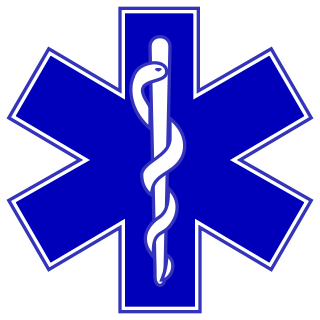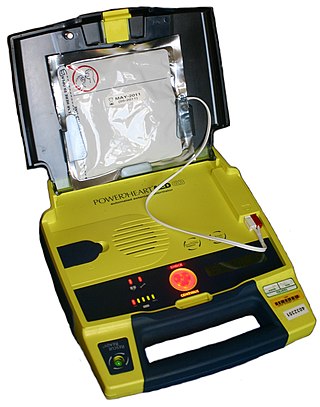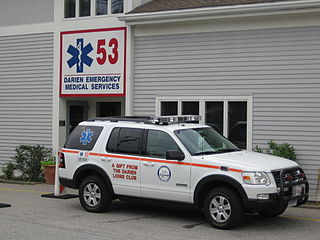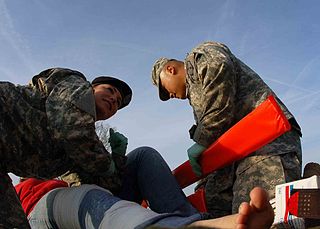Related Research Articles

Emergency medical services (EMS), also known as ambulance services or paramedic services, are emergency services that provide urgent pre-hospital treatment and stabilisation for serious illness and injuries and transport to definitive care. They may also be known as a first aid squad, FAST squad, emergency squad, ambulance squad, ambulance corps, life squad or by other initialisms such as EMAS or EMARS.

Cardiac arrest, also known as sudden cardiac arrest, is when the heart suddenly and unexpectedly stops beating. As a result blood will not be pumped around the body in normal circulation, consciousness will be rapidly lost, and breathing will be abnormal or absent. Without immediate intervention such as cardiopulmonary resuscitation (CPR), and possibly defibrillation, death will occur within minutes.

Cardiopulmonary resuscitation (CPR) is an emergency procedure consisting of chest compressions often combined with artificial ventilation, or mouth to mouth in an effort to manually preserve intact brain function until further measures are taken to restore spontaneous blood circulation and breathing in a person who is in cardiac arrest. It is recommended for those who are unresponsive with no breathing or abnormal breathing, for example, agonal respirations.

An emergency medical technician is a medical professional that provides emergency medical services. EMTs are most commonly found serving on ambulances and in fire departments in the US and Canada, as full-time and some part-time departments require their firefighters to be EMT certified.

A paramedic is a healthcare professional trained in the medical model, whose main role has historically been to respond to emergency calls for medical help outside of a hospital. Paramedics work as part of the emergency medical services (EMS), most often in ambulances. They also have roles in emergency medicine, primary care, transfer medicine and remote/offshore medicine. The scope of practice of a paramedic varies between countries, but generally includes autonomous decision making around the emergency care of patients.

An automated external defibrillator or automatic electronic defibrillator (AED) is a portable electronic device that automatically diagnoses the life-threatening cardiac arrhythmias of ventricular fibrillation (VF) and pulseless ventricular tachycardia, and is able to treat them through defibrillation, the application of electricity which stops the arrhythmia, allowing the heart to re-establish an effective rhythm.
Basic life support (BLS) is a level of medical care which is used for patients with life-threatening illnesses or injuries until they can be given full medical care by advanced life support providers. It can be provided by trained medical personnel, such as emergency medical technicians, and by qualified bystanders.
The Seattle & King County Emergency Medical Services System is a fire-based two-tier response system providing prehospital basic and advanced life support services.

Traumatic cardiac arrest (TCA) is a condition in which the heart has ceased to beat due to blunt or penetrating trauma, such as a stab wound to the thoracic area. It is a medical emergency which will always result in death without prompt advanced medical care. Even with prompt medical intervention, survival without neurological complications is rare. In recent years, protocols have been proposed to improve survival rate in patients with traumatic cardiac arrest, though the variable causes of this condition as well as many coexisting injuries can make these protocols difficult to standardize. Traumatic cardiac arrest is a complex form of cardiac arrest often derailing from advanced cardiac life support in the sense that the emergency team must first establish the cause of the traumatic arrest and reverse these effects, for example hypovolemia and haemorrhagic shock due to a penetrating injury.

The American College of Cardiology (ACC), based in Washington, D.C., is a nonprofit medical association established in 1949. It bestows credentials upon cardiovascular specialists who meet its qualifications. Education is a core component of the college, which is also active in the formulation of health policy and the support of cardiovascular research.

A nontransporting EMS vehicle, also known as a squad car, fly-car, response vehicle, quick response service (QRS) vehicle,chase car, or fast response vehicle, is a vehicle that responds to and provides emergency medical services (EMS) without the ability to transport patients. For patients whose condition requires transport, an ambulance is necessary. In some cases they may fulfill other duties when not participating in EMS operations, such as policing or fire suppression.

The California Emergency Medical Services Authority is an agency of California State government. The California EMS Authority is one of the thirteen departments within the California Health and Human Services Agency. The director is required to be a physician with substantial experience in emergency medicine. Elizabeth Basnett is the current Acting Director.

In the United States, the paramedic is a allied health professional whose primary focus is to provide advanced emergency medical care for patients who access Emergency Medical Services (EMS). This individual possesses the complex knowledge and skills necessary to provide patient care and transportation. Paramedics function as part of a comprehensive EMS response under physician medical direction. Paramedics often serve in a prehospital role, responding to Public safety answering point (9-1-1) calls in an ambulance. The paramedic serves as the initial entry point into the health care system. A standard requirement for state licensure involves successful completion of a nationally accredited Paramedic program at the certificate or associate degree level.

Louisville Metro Emergency Medical Services is the primary provider of pre-hospital life support and emergency care within Louisville-Jefferson County, Kentucky. LMEMS is a governmental department that averages 90,000 calls for service, both emergency and non-emergency, each year.
Door-to-balloon is a time measurement in emergency cardiac care (ECC), specifically in the treatment of ST segment elevation myocardial infarction. The interval starts with the patient's arrival in the emergency department, and ends when a catheter guidewire crosses the culprit lesion in the cardiac cath lab. Because of the adage that "time is muscle", meaning that delays in treating a myocardial infarction increase the likelihood and amount of cardiac muscle damage due to localised hypoxia, ACC/AHA guidelines recommend a door-to-balloon interval of no more than 90 minutes. As of 2006 in the United States, fewer than half of STEMI patients received reperfusion with primary percutaneous coronary intervention (PCI) within the guideline-recommended timeframe. It has become a core quality measure for the Joint Commission on Accreditation of Healthcare Organizations (TJC).
The chain of survival refers to a series of actions that, properly executed, reduce the mortality associated with sudden cardiac arrest. Like any chain, the chain of survival is only as strong as its weakest link. The six interdependent links in the chain of survival are early recognition of sudden cardiac arrest and access to emergency medical care, early CPR, early defibrillation, early advanced cardiac life support, and physical and emotional recovery. The first three links in the chain can be performed by lay bystanders, while the second three links are designated to medical professionals. Currently, between 70 and 90% of cardiac arrest patients die before they reach the hospital. However, a cardiac arrest does not have to be lethal if bystanders can take the right steps immediately.

In the United States, emergency medical services (EMS) provide out-of-hospital acute medical care and/or transport to definitive care for those in need. They are regulated at the most basic level by the National Highway Traffic Safety Administration, which sets the minimum standards that all states' EMS providers must meet, and regulated more strictly by individual state governments, which often require higher standards from the services they oversee.

Emergency medical responders are people who are specially trained to provide out-of-hospital care in medical emergencies. There are many different types of emergency medical responders, each with different levels of training, ranging from first aid and basic life support. Emergency medical responders have a very limited scope of practice and have the least amount of comprehensive education, clinical experience or clinical skills of emergency medical services (EMS) personnel. The EMR program is not intended to replace the roles of emergency medical technicians or paramedics and their wide range of specialties. Emergency medical responders typically assist in rural regions providing basic life support where pre-hospital health professionals are not available due to limited resources or infrastructure.
GoodSAM is a global emergency and volunteer service platform and associated community co-founded by Mark Wilson OBE, Ali Ghorbangholi OBE and Ali Haddad in 2013. It is used by ambulance, police, fire, government, charity and health services to improve immediate emergency management, largely through video enabling Instant-On-Scene video assessment and from the platform’s ability to alert trusted responders to provide immediate help. It is also the platform used to deploy nearly 800,000 NHS Volunteers across the UK to support those isolating or suffering with Covid
The Virginia Beach Department of Emergency Medical Services is the 911 EMS provider for Virginia Beach, Virginia. Virginia Beach is the largest city in the United States with a volunteer based EMS system. Since the 1940s Virginia Beach has offered free pre-hospital emergency services through 10 volunteer rescue squads supported by 1,100+ volunteers throughout the city. Virginia beach EMS has also been a leader in a variety of pre-hospital technologies including 12-lead transmission, EZ-IO technology and therapeutic hypothermia, rapid sequence induction, video laryngoscope, end tidal CO2 monitoring, STEMI and Stroke programs and community CPR, among others. These programs and more have contributed to the 36% cardiac arrest survival rate (2012). I
References
- ↑ "Boosting the Odds of Surviving Cardiac Arrest," MedGenMed 2006;8(3):44, Accessed June 21, 2008.
- ↑ "How Good is that Data?" Emergency Medical Services, July 2007. Accessed June 21, 2008.
- ↑ "Reconciling fractured communications data," Emergency Medical Services, May 2007. Accessed June 21, 2008.
- ↑ "Six Minutes to Live or Die," USA Today , May 20, 2005. Accessed June 21, 2008.
- ↑ "Atlanta becomes a template for improving EMS," USA Today , August 21, 2007. Accessed July 21, 2008.
- ↑ "Comprehensive Monitoring Pinpoints 911 Dispatch Inefficiencies, Leading to Communication and Deployment Improvements That Increase Cardiac Arrest Survival," Agency for Healthcare Research and Quality, Updated May 20, 2008. Accessed June 22, 2008.
- ↑ "Expanding the Cardiac Arrest Registry to Enhance Survival (CARES) Program," Archived May 18, 2006, at the Wayback Machine National Center for Chronic Disease Prevention and Health Promotion, Division for Heart Disease and Stroke Prevention (NCCDPHP), Accessed June 21, 2008.
- 1 2 3 4 5 6 7 8 9 "Current CARES Participants," CARES, Accessed June 21, 2008.
- 1 2 3 4 5 6 7 8 9 10 11 12 13 Cardiac Arrest Registry to Enhance Survival (CARES), September 10, 2007. Accessed June 21, 2008.
- ↑ "Move Over Seattle…Here Comes Anchorage Alaskan City Achieves 40% Save Rate," Sudden Cardiac Arrest Foundation, February 25, 2008. Accessed June 21, 2008.
- 1 2 3 4 5 6 7 8 9 10 11 12 13 14 15 16 17 18 19 20 21 22 23 24 25 26 27 B McNally et al., "Cardiac Arrest Registry to Enhance Survival," May 9, 2008.
- ↑ "Cleveland Urged to Track Cardiac Survival Rate," EMS Responder, reprint of article from The Plain Dealer , October 16, 2007. Accessed June 22, 2008.
- ↑ "Cardiac Response Lags in L.A.", The Washington Post , May 29, 2008. Accessed June 21, 2008.